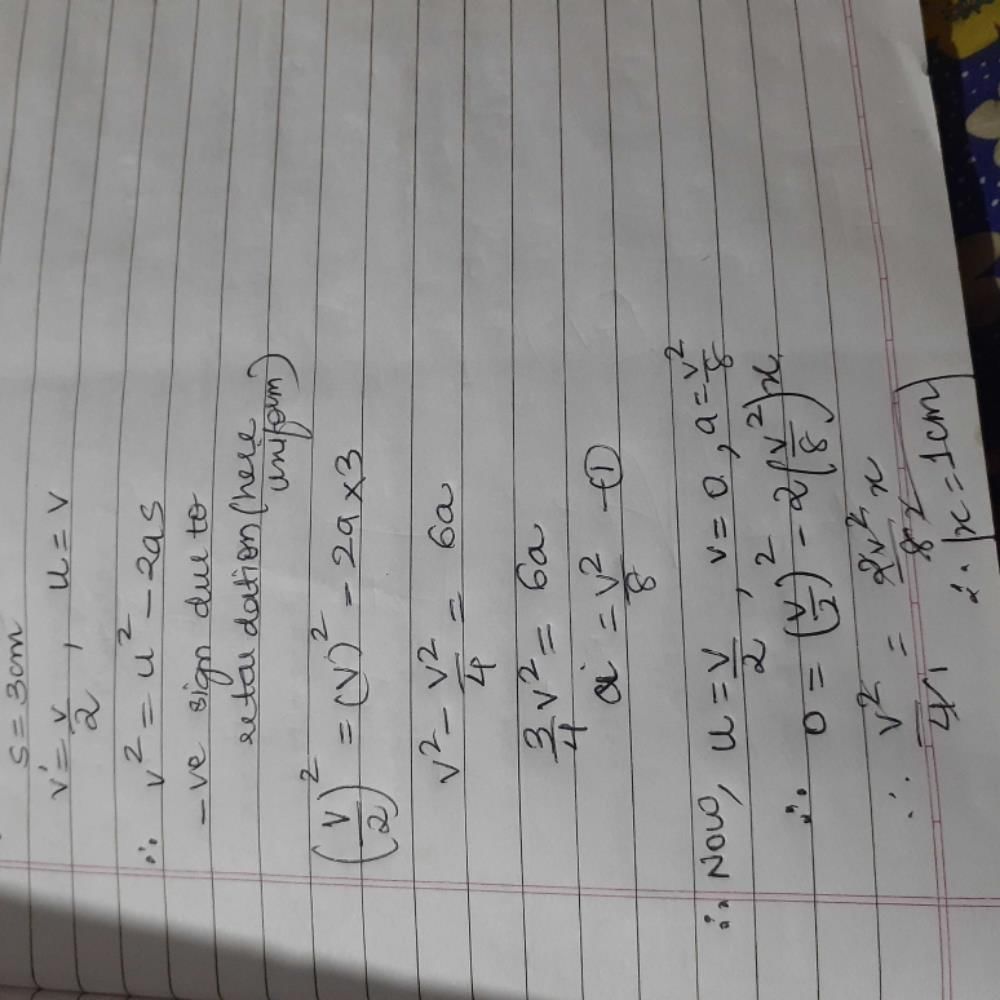Class 11 Exam > Class 11 Questions > If a body losses half of its velocity on pene...
Start Learning for Free
If a body losses half of its velocity on penetrating 3 cm in a wooden block, then how much will it penetrate more before coming to rest ? [AIEEE 2002]
- a)1 cm
- b)2cm
- c)3cm
- d)4cm
Correct answer is option 'A'. Can you explain this answer?
Verified Answer
If a body losses half of its velocity on penetrating 3 cm in a wooden ...
Let the initial velocity of the body be u. Its velocity becomes u/2 after penetrating 3 cm in the block. We can calculate the deceleration of the body using these.
v2= u2 +2as
u2/4 = u2 + 2ax3
-3u2/4 = 6a
a = -u2/8
Now, we can calculate the distance the body travels till it comes to rest.
v2 = u2 + 2as
0 = u2 +2x(-u2/8)xs
u2 = u2s/4
s = 4 cm
Therefore, the body penetrates 1 cm (4-3=1cm) more before coming to rest.
I hope you understand the concept.
Most Upvoted Answer
If a body losses half of its velocity on penetrating 3 cm in a wooden ...

Free Test
FREE
| Start Free Test |
Community Answer
If a body losses half of its velocity on penetrating 3 cm in a wooden ...
Given, the body loses half of its velocity on penetrating 3 cm in a wooden block. Let the initial velocity of the body be v and the distance it penetrates before coming to rest be x.
Using the formula for distance penetrated by a body in a medium, we have:
d = (1/2)mv^2/(Ffriction)
where d is the distance penetrated, m is the mass of the body, Ffriction is the frictional force acting on the body, and v is the initial velocity.
Since the body loses half of its velocity on penetrating 3 cm in a wooden block, we can write:
v/2 = (1/2)v - (Ffriction/m)(3 cm)
Simplifying, we get:
(Ffriction/m)x = (1/2)v
x = (m/2Ffriction)v
Now, we need to find the value of x. To do so, we need to know the value of the frictional force acting on the body.
Assuming that the frictional force is proportional to the velocity of the body, we can write:
Ffriction = kv
where k is a constant of proportionality.
Substituting this value of Ffriction in the equation for x, we get:
x = (m/2kv)v
x = (1/2k)m(v^2)
Since the distance penetrated is directly proportional to the square of the initial velocity, if the body loses half of its velocity, it will penetrate one-fourth of the distance it originally penetrated before coming to rest.
Hence, the body will penetrate 1 cm more before coming to rest. Therefore, option A is the correct answer.
Using the formula for distance penetrated by a body in a medium, we have:
d = (1/2)mv^2/(Ffriction)
where d is the distance penetrated, m is the mass of the body, Ffriction is the frictional force acting on the body, and v is the initial velocity.
Since the body loses half of its velocity on penetrating 3 cm in a wooden block, we can write:
v/2 = (1/2)v - (Ffriction/m)(3 cm)
Simplifying, we get:
(Ffriction/m)x = (1/2)v
x = (m/2Ffriction)v
Now, we need to find the value of x. To do so, we need to know the value of the frictional force acting on the body.
Assuming that the frictional force is proportional to the velocity of the body, we can write:
Ffriction = kv
where k is a constant of proportionality.
Substituting this value of Ffriction in the equation for x, we get:
x = (m/2kv)v
x = (1/2k)m(v^2)
Since the distance penetrated is directly proportional to the square of the initial velocity, if the body loses half of its velocity, it will penetrate one-fourth of the distance it originally penetrated before coming to rest.
Hence, the body will penetrate 1 cm more before coming to rest. Therefore, option A is the correct answer.

|
Explore Courses for Class 11 exam
|

|
Question Description
If a body losses half of its velocity on penetrating 3 cm in a wooden block, then how much will it penetrate more before coming to rest ? [AIEEE 2002]a)1 cmb)2cmc)3cmd)4cmCorrect answer is option 'A'. Can you explain this answer? for Class 11 2025 is part of Class 11 preparation. The Question and answers have been prepared according to the Class 11 exam syllabus. Information about If a body losses half of its velocity on penetrating 3 cm in a wooden block, then how much will it penetrate more before coming to rest ? [AIEEE 2002]a)1 cmb)2cmc)3cmd)4cmCorrect answer is option 'A'. Can you explain this answer? covers all topics & solutions for Class 11 2025 Exam. Find important definitions, questions, meanings, examples, exercises and tests below for If a body losses half of its velocity on penetrating 3 cm in a wooden block, then how much will it penetrate more before coming to rest ? [AIEEE 2002]a)1 cmb)2cmc)3cmd)4cmCorrect answer is option 'A'. Can you explain this answer?.
If a body losses half of its velocity on penetrating 3 cm in a wooden block, then how much will it penetrate more before coming to rest ? [AIEEE 2002]a)1 cmb)2cmc)3cmd)4cmCorrect answer is option 'A'. Can you explain this answer? for Class 11 2025 is part of Class 11 preparation. The Question and answers have been prepared according to the Class 11 exam syllabus. Information about If a body losses half of its velocity on penetrating 3 cm in a wooden block, then how much will it penetrate more before coming to rest ? [AIEEE 2002]a)1 cmb)2cmc)3cmd)4cmCorrect answer is option 'A'. Can you explain this answer? covers all topics & solutions for Class 11 2025 Exam. Find important definitions, questions, meanings, examples, exercises and tests below for If a body losses half of its velocity on penetrating 3 cm in a wooden block, then how much will it penetrate more before coming to rest ? [AIEEE 2002]a)1 cmb)2cmc)3cmd)4cmCorrect answer is option 'A'. Can you explain this answer?.
Solutions for If a body losses half of its velocity on penetrating 3 cm in a wooden block, then how much will it penetrate more before coming to rest ? [AIEEE 2002]a)1 cmb)2cmc)3cmd)4cmCorrect answer is option 'A'. Can you explain this answer? in English & in Hindi are available as part of our courses for Class 11.
Download more important topics, notes, lectures and mock test series for Class 11 Exam by signing up for free.
Here you can find the meaning of If a body losses half of its velocity on penetrating 3 cm in a wooden block, then how much will it penetrate more before coming to rest ? [AIEEE 2002]a)1 cmb)2cmc)3cmd)4cmCorrect answer is option 'A'. Can you explain this answer? defined & explained in the simplest way possible. Besides giving the explanation of
If a body losses half of its velocity on penetrating 3 cm in a wooden block, then how much will it penetrate more before coming to rest ? [AIEEE 2002]a)1 cmb)2cmc)3cmd)4cmCorrect answer is option 'A'. Can you explain this answer?, a detailed solution for If a body losses half of its velocity on penetrating 3 cm in a wooden block, then how much will it penetrate more before coming to rest ? [AIEEE 2002]a)1 cmb)2cmc)3cmd)4cmCorrect answer is option 'A'. Can you explain this answer? has been provided alongside types of If a body losses half of its velocity on penetrating 3 cm in a wooden block, then how much will it penetrate more before coming to rest ? [AIEEE 2002]a)1 cmb)2cmc)3cmd)4cmCorrect answer is option 'A'. Can you explain this answer? theory, EduRev gives you an
ample number of questions to practice If a body losses half of its velocity on penetrating 3 cm in a wooden block, then how much will it penetrate more before coming to rest ? [AIEEE 2002]a)1 cmb)2cmc)3cmd)4cmCorrect answer is option 'A'. Can you explain this answer? tests, examples and also practice Class 11 tests.

|
Explore Courses for Class 11 exam
|

|
Signup for Free!
Signup to see your scores go up within 7 days! Learn & Practice with 1000+ FREE Notes, Videos & Tests.



















